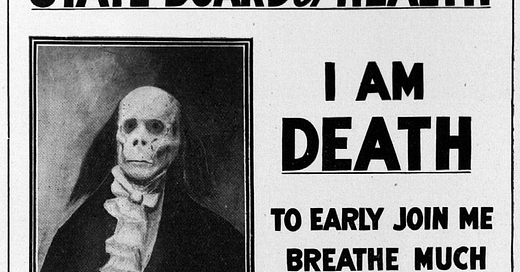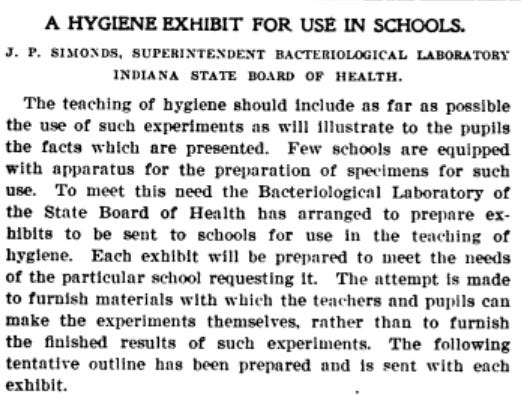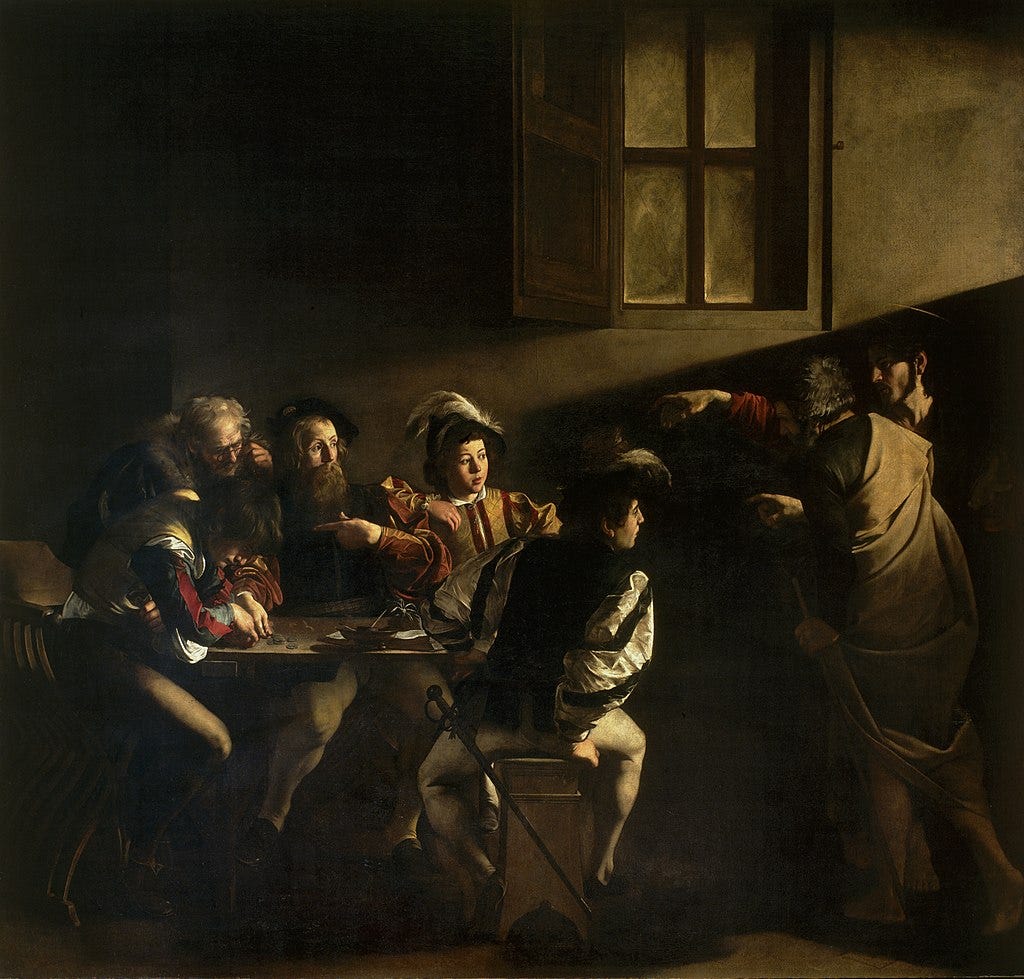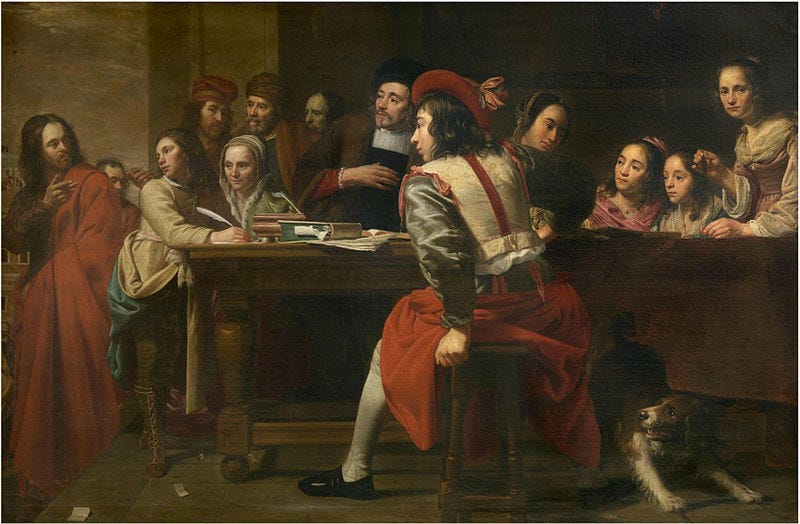The Week in Meep: Indiana State Board of Health Watching Out For You, and St. Matthew's Feast Day
Do NOT neglect your bowels
A helpful piece of public info:
The original source was Monthly Bulletin, of the Indiana State Board of Health, 1912 Vol. 15 No. 4, on page numbered 40, but the 4th page in that number.
There was no text around it to explain anything inside.
The Indiana Historical Society sells a magnet version.
Other than the “foul air” aspect (and I’m not sure if they’re referring to factory-related smog or if they’re hung up on “miasmas”, which I thought was out-of-favor by 1912), look that their focus is on diet-related items and behavior: booze, late and rapid eating, rich food (gout? diabetes?), and potentially constipation/diarrhea.
Demonstrations for the classroom, 1912
There was no textual explanation for the poster in this bulletin, but there were other items.
I liked this one:
For simplicity, I will summarize the exhibits: slides of 4 different pathogens, and 8 Petri dishes (with prepared agar in it) for experiments.
The pathogens: [on slides for viewing under microscopes or culturing on the Petri dishes]
Diphtheria
Tuberculosis
Staph
Typhoid fever
They have instructions on preventing contamination of the Petri dishes, unless you want to.
Experiment 1: Have a student w/ dirty hands touch the agar (I suppose) where it’s marked D (for dirty), then wash their hands w/ soap, then touch the jelly where it’s marked C (for clean). Over time, there should be growth around the D, and none or less around the C.
Experiment 2: This one involves two Petri dishes (#2 & #3), and a room that has still air and relatively warm. Open dish #2 for 2 minutes and close up. Then vigorously sweep in the room, moving stuff in the air around. Open dish #3 for two minutes in the room. Supposedly there will be more bacterial growth in dish #3. I guess this relates to airborne bacteria.
Experiment 3: This one is testing the school’s water, using dishes #4 & #5. Just take an eye dropper of the school’s water, untreated, and drop into dish #4. Then take some of the school’s water, boil it, and drop some of the boiled water into #5.
Experiment 4: This is dish #6, and involves transferring germs from a cup from an infected person. This one seems iffy.
Experiment 5: They get a kid to cough directly on dish #7 while open. Fabulous.
Experiment 6: This is a prepared dish sent to the classroom… with typhoid pathogens in dish #8. Seeded in a pattern spelling TYPHOID. There’s a point about bright sunlight killing the typhoid pathogens… which would be relevant if humans were made of agar and the pathogens were on our surface.
I do remember doing a similar experiment as #1 in school. Direct experimentation to prove the effectiveness of hygiene actions, such as boiling water or washing one’s hands, is lots of fun at school.
I did a different sort of experiment in a science research class, where I was doing a fungal growth experiment in different mineral baths with a fellow student. But it kept getting contaminated with bacteria, as people kept messing with our mineral baths.
We talked with our teacher about this, especially as it was a pain in the ass to get all the samples prepared, so we got permission to label our bench:
WARNING: URINE SAMPLES
DO NOT DISTURB
The second time, our experiment was not contaminated.
St. Matthew in artwork
Yesterday, September 21st, was St. Matthew’s feast day.
St. Matthew, having been a tax collector when called by Our Lord, is patron to accountants (among other professions).
That said, he is not usually portrayed as an accountant or tax collector. Being one of the four gospel writers, he’s usually portrayed holding a book or scroll. As well, when you have a grouping of the 4 evangelists (gospel writers), which are a lion, bull, person, and eagle — Matthew is the person. So you don’t get anything particularly strange with depictions of Matthew…
….except for that axe/hatchet, which sometimes shows up. As with a lot of the apostles, it’s assumed he was martyred… somewhere. There are traditions. But unlike with people like Sts. Peter and Paul, we’re not sure where or how he died.
But it’s pretty cool to draw him holding a weapon, so some artists included that.
A lot of martyrs will be depicted holding something related to their deaths… like Lucy with a platter with her eyeballs on them.
Back to Matthew: here is Caravaggio’s rendering of the scene of Matthew being called by Jesus from the counting house:
I like religious artworks where the scenes are set contemporary with the artist’s own time and place.
Another variety is that everybody but Jesus is in contemporary outfits, or that there is perhaps a mix (it’s difficult to tell with some of the people in the background):
With the women and girls in the mix, and the dog, I’m going to guess the artist, Jacob van Oost, may have the family of a patron in this painting lined up at the table, with father and mother in the middle, and the daughters spread out. (and the family dog foregrounded.) The men in the background could be artist’s models, as could be the young man modeling for Matthew, and interesting choice as the tax collector.
Especially as most artists have been choosing to depict Matthew as old…. (which he certainly was by the time he wrote down his gospel.)
Given that thought, let me leave you with another common depiction of St. Matthew, which is of St. Matthew with an angel, as he writes out his gospel:
Very thoughtfully, the angel holds Matthew’s place as he nods off during his work.
With modern technology, auto-save sometimes works as well.










